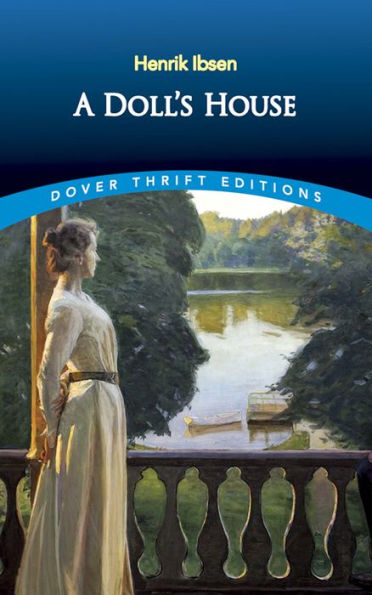Table of Contents
Acknowledgements
Introduction
Henrik Ibsen and
A Doll’s House: A Brief Chronology
A Note on the Text
A Doll’s House
A Note on Nora’s Final Exit
Appendix A: Contemporary Adaptations, Sequels, and Parodies
- 1. From a letter from Ibsen to a Danish newspaper regarding the ending of the play (17 February 1880)
- 2. Ibsen’s alternative ending (1880)
- 3. From Henry Arthur Jones and Henry Herman, Breaking a Butterfly (1882)
- 4. From August Strindberg, “A Doll’s House” (1884)
- 5. From Walter Besant, “The Doll’s House—and After,” The English Illustrated Magazine (October 1890)
- 6. From Ednah Dow Cheney, Nora’s Return: A Sequel to The Doll’s House (1890)
- 7. From Israel Zangwill and Eleanor Marx-Aveling, “A Doll’s House Repaired,” Time (March 1891)
- 8. From F. Anstey, “Nora; or, The Bird-Cage,” Mr Punch’s Pocket Ibsen (1893)
Appendix B: William Archer and
A Doll’s House - 1. From Archer’s review of the first performance in England of A Doll’s House, Dramatic Review (4 April 1885)
- 2. From a letter to Charles Archer (13 June 1889)
- 3. From “Ibsen and English Criticism,” Fortnightly Review (July 1889)
- 4. From William Archer, The Theatrical “World” for 1893 (1894)
- 5. From The Collected Works of Henrik Ibsen (1906)
Appendix C: Bernard Shaw and
A Doll’s House - 1. On A Doll’s House, Penny Illustrated Paper (1 June 1889)
- 2. From Shaw’s review of A Doll’s House, Manchester Guardian (8 June 1889)
- 3. From a letter to William Archer (11 June 1889)
- 4. From “Still after the Doll’s House,” Time (February 1890)
- 5. From The Quintessence of Ibsenism (1891)
- 6. From “A Doll’s House Again,” Saturday Review (15 May 1897)
- 7. From “The Technical Novelty in Ibsen’s Plays,” The Quintessence of Ibsenism (1913)
Appendix D: The Critics
- 1. In London
- a. From The Era (28 March 1885)
- b. From The Times (8 June 1889)
- c. From The Globe (8 June 1889)
- d. From The Daily Telegraph (8 June 1889)
- e. From The Pall Mall Gazette (8 June 1889)
- f. From The Spectator (21 June 1889)
- g. From Clement Scott, “A Doll’s House,” The Theatre (1 July 1889)
- 2. In America
- a. From The Courier-Journal [Louisville, Kentucky] (8 December 1883)
- b. From The New York Times (27 September 1889)
- c. From The Boston Globe (31 October 1889)
- d. From The [New York] Sun (22 December 1889)
- e. From The New York Times (22 December 1889)
- f. From The [New York] Evening World (23 December 1889)
- g. From The [New York] Sun (16 February 1894)
- h. From The [New York] Evening World (7 June 1895)
- 3. In Montreal and Sydney
- a. From The [Montreal] Gazette (18 February 1890)
- b. From The Sydney Morning Herald (19 July 1890)
Appendix E: Feminism
- 1. Henrik Ibsen, “Notes for the Tragedy of Modern Times” (19 October 1878)
- 2. From Henrietta Frances Lord, preface to her translation of A Doll’s House (1882)
- 3. From August Strindberg, preface to Getting Married (1884)
- 4. From Havelock Ellis, The New Spirit (1890)
- 5. From Ellen Battelle Dietrick, “The Doll’s House—T’Other Side,” Women’s Penny Paper (15 and 22 March 1890)
- 6. From Annie Nathan Meyer, “Ibsen’s Attitude Towards Woman,” The Critic [New York] (22 March 1890)
- 7. From Max Nordau, Degeneration (1895)
- 8. From Ibsen’s speech to the Norwegian Women’s Rights League (26 May 1898)
- 9. From Louie Bennett, “Ibsen as a Pioneer of the Woman Movement,” The Westminster Review (March 1910)
Appendix F: Acting Nora
- 1. From “Nora Helmer off for the Antipodes: An Interview with Miss Janet Achurch,” The Pall Mall Gazette (5 July 1889)
- 2. From “Ethel Barrymore on Nora Helmer” (6 May 1905)
- 3. Alla Nazimova, “Ibsen’s Women,” The Independent (17 October 1907)
- 4. From Elizabeth Robins, Ibsen and the Actress (1928)
- 5. From Liv Ullmann, Changing (1976)
Works Cited and Select Bibliography






